
Outdoor vivaria
Design factors considered.
The various requirements which need to be met are set out below. I also set out my particular techniques for meeting those requirements but while these are effective they are not the only way. You will find other resources on the internet that offer other, equally good, ideas. Please, however, ensure that you accept what are only proven ideas such as might be evidenced by consistent success in breeding. Also please remember that even within as small a country as the UK a suitable outdoor vivaria in one part might not work as well - or at least with the same species, in another.
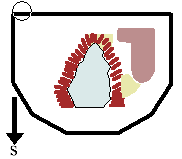 Orientation. In this part of
the world almost all herps need
a site which includes a
sheltered but sunny southerly
exposure in order to maintain
body temperature. During the
summer, they will also use
east-facing slopes in the
morning and west facing slopes
in the afternoon. As a natural
consequence an East-West
orientation is preferred,
ideally with a slope facing
towards the south. While our
garden actually has an east
facing slope the vivaria are
terraced up the garden and each
has then been the subject of the
necessary earthworks to create
sunny and sheltered exposures.
Note in the simple diagram
aside, the vivarium itself faces
south and there are slopes (in
brown) facing in all directions
except north. The pink area is a
hollow wall and the two yellow
areas open sand.
Orientation. In this part of
the world almost all herps need
a site which includes a
sheltered but sunny southerly
exposure in order to maintain
body temperature. During the
summer, they will also use
east-facing slopes in the
morning and west facing slopes
in the afternoon. As a natural
consequence an East-West
orientation is preferred,
ideally with a slope facing
towards the south. While our
garden actually has an east
facing slope the vivaria are
terraced up the garden and each
has then been the subject of the
necessary earthworks to create
sunny and sheltered exposures.
Note in the simple diagram
aside, the vivarium itself faces
south and there are slopes (in
brown) facing in all directions
except north. The pink area is a
hollow wall and the two yellow
areas open sand.
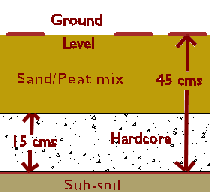 Drainage.
While many amphibians are
unconcerned about drainage, the
vast majority of reptiles prefer
a well drained habitat where
they can be sure the soil is not
too damp. Even amphibians will
thrive in the same conditions so
long as they have access to
water - especially for breeding.
People who live on sandy soil
will not need to worry further
about this. In our case,
however, we live on fairly heavy
soil which can be very moisture
retentive over a layer of chalk.
As a result, every single
outdoor vivarium starts as a
hole at least 45 cms deep with
about 15 cms of packed hardcore
at the bottom of it. Although
some of our local soil is
replaced over this a good
proportion is replaced with a
mixture of peat and sand. This
ensures that the habitat does not
become waterlogged.
Drainage.
While many amphibians are
unconcerned about drainage, the
vast majority of reptiles prefer
a well drained habitat where
they can be sure the soil is not
too damp. Even amphibians will
thrive in the same conditions so
long as they have access to
water - especially for breeding.
People who live on sandy soil
will not need to worry further
about this. In our case,
however, we live on fairly heavy
soil which can be very moisture
retentive over a layer of chalk.
As a result, every single
outdoor vivarium starts as a
hole at least 45 cms deep with
about 15 cms of packed hardcore
at the bottom of it. Although
some of our local soil is
replaced over this a good
proportion is replaced with a
mixture of peat and sand. This
ensures that the habitat does not
become waterlogged.
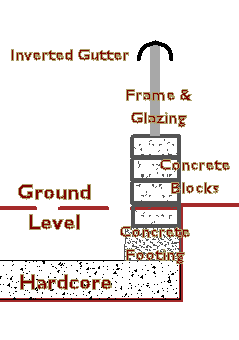 Escape
proofing. This can be
achieved in many ways.
Generally, however, the vivarium
is bounded by some sort of wall,
constructed of a not too easily
climbable material with a
substantial overlap at the top.
It is also essential that the
wall itself extend deep enough
below ground to prevent the
animals from digging out. Many
lizards and some amphibians are
extremely accomplished burrowers
and, especially if you have a
light soil the depth of the wall
would need to be significant. In
our case, the retaining wall is
actually built on a concrete
base using the perimeter of the
drainage hardcore as a
foundation. Since the wall
extends down to the hardcore the
risk of digging out is
negligible. The wall itself is
built of lightweight concrete
blocks laid flat and raising to
a height of between 20 cms and
60 cms (reflecting the slope of
the garden) above ground. Above
this there is a glass wall in
aluminium framing between 30 and
60 cms high which is topped off
by inverted plastic guttering.
Last, but not least, when
furnishing the vivarium one must
ensure that neither plants nor
structures are near enough or
tall enough to allow animals to
jump from them to the top of the
wall.
Escape
proofing. This can be
achieved in many ways.
Generally, however, the vivarium
is bounded by some sort of wall,
constructed of a not too easily
climbable material with a
substantial overlap at the top.
It is also essential that the
wall itself extend deep enough
below ground to prevent the
animals from digging out. Many
lizards and some amphibians are
extremely accomplished burrowers
and, especially if you have a
light soil the depth of the wall
would need to be significant. In
our case, the retaining wall is
actually built on a concrete
base using the perimeter of the
drainage hardcore as a
foundation. Since the wall
extends down to the hardcore the
risk of digging out is
negligible. The wall itself is
built of lightweight concrete
blocks laid flat and raising to
a height of between 20 cms and
60 cms (reflecting the slope of
the garden) above ground. Above
this there is a glass wall in
aluminium framing between 30 and
60 cms high which is topped off
by inverted plastic guttering.
Last, but not least, when
furnishing the vivarium one must
ensure that neither plants nor
structures are near enough or
tall enough to allow animals to
jump from them to the top of the
wall.
Predator proofing. Most of us live in close proximity to other people which means that domestic cats are a major potential predator. In our case we have two cats of our own. One of them would happily sit in the vivarium watching the lizards while the other would try to catch and kill every one of them! Some birds can also be potential predators. How this is addressed is very much related to the design of the vivarium. A small garden vivarium could simply have a lightweight timber frame covered in netting over the top. Obviously if you use this approach then you must ensure it is easily removable for access and yet is also fairly firmly secured the rest of the time Also, of course, you have to ensure that the interior decor is not high enough to allow animals to reach the netting and use this as an escape route. Where, like us, the vivaria are large the whole assembly can be enclosed in what might be described as a large fruit cage, keeping predators out of the entire area while allowing access via a gate. In our case this is built of reasonably substantial timber covered in wire netting which withstands cat's claws! There is also danger from burrowing predators such as moles which will kill and eat lizards in hibernation. Fortunately our design prevents this due to the packed layer of hardcore for drainage.
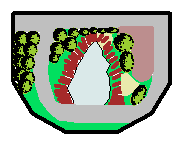 Decor and
landscaping. This is
dependent on the species one
wishes to keep. For amphibians,
for example, the vivarium would
need to have a good sized pond.
Even for lizards a pond is
beneficial as a water source in
extremely dry weather. The
interior could, as with our
largest vivarium, be sculpted to
give east, south and west slopes
surrounding a pond. We have also
added a wall with a hollow
interior which provides both a
popular basking place and
additional hidey holes within
it. Vegetation should so far as
practical, reflect natural
habitat. In the UK, and much of
Europe, prime habitat is
heathland and as a result the
plants that predominate in our
vivaria are Erica and Calluna
the two major heather families.
A combination such as this will
actually suit the majority of
European herps.
Decor and
landscaping. This is
dependent on the species one
wishes to keep. For amphibians,
for example, the vivarium would
need to have a good sized pond.
Even for lizards a pond is
beneficial as a water source in
extremely dry weather. The
interior could, as with our
largest vivarium, be sculpted to
give east, south and west slopes
surrounding a pond. We have also
added a wall with a hollow
interior which provides both a
popular basking place and
additional hidey holes within
it. Vegetation should so far as
practical, reflect natural
habitat. In the UK, and much of
Europe, prime habitat is
heathland and as a result the
plants that predominate in our
vivaria are Erica and Calluna
the two major heather families.
A combination such as this will
actually suit the majority of
European herps.
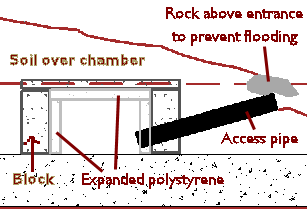 Hibernaculum. A hibernaculum
is a place where animals can
hibernate. While many of the
animals will be only to happy to
dig their own burrows some
prefer them to be ready made -
in the wild they might use
rodent burrows for example.
During the construction phase it
can be a good idea to construct
a simple shelter of lightweight
blocks lined internally on the
sides and top with expanded
polystyrene. A drainage pipe can
be laid to provide access and
the whole thing covered in the
landscaping stage with just the
end of the drainage pipe
emerging for access. All of our
vivaria have something like this
within them. It must be
remembered that the animals must
be able to climb in the access
pipe. In the case of smooth
pipes such as plastic drain
pipe, coating the inside with
diluted exterior PVA adhesive,
sprinkling sand on it and
allowing it to dry will achieve
this.
Hibernaculum. A hibernaculum
is a place where animals can
hibernate. While many of the
animals will be only to happy to
dig their own burrows some
prefer them to be ready made -
in the wild they might use
rodent burrows for example.
During the construction phase it
can be a good idea to construct
a simple shelter of lightweight
blocks lined internally on the
sides and top with expanded
polystyrene. A drainage pipe can
be laid to provide access and
the whole thing covered in the
landscaping stage with just the
end of the drainage pipe
emerging for access. All of our
vivaria have something like this
within them. It must be
remembered that the animals must
be able to climb in the access
pipe. In the case of smooth
pipes such as plastic drain
pipe, coating the inside with
diluted exterior PVA adhesive,
sprinkling sand on it and
allowing it to dry will achieve
this.
Appearance. Lastly, while not necessary to the animal's well being it might be necessary to bear in mind that other people might be able to see the vivarium and, quite simply, don't want to see something ugly in the garden. Obviously it might be wise to consider this in the design stage. We have made very effort to make our vivaria, if not things of beauty, at least not eyesores! You should find some pictures in the gallery.
Summary. An outdoor vivarium must cover all but the last of the above factors. If the last is given proper consideration as well, it might be the final factor that swings things in favour with your partner of you being able to build an outdoor vivaria in your garden. Hopefully, the above notes will give you some idea of the factors to be taken into account, the problems that might be considered and ways in which you might address them. So ........ start digging!
NEXT: Covered but unheated vivaria